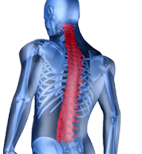Treatments for Spinal Compression Fractures



Osteoporosis, a disease that gradually weakens bones, causing them to become brittle, affects more than 28 million Americans. If not prevented or if left untreated, osteoporosis can progress painlessly until a bone breaks.
Along with hip and wrist fractures, severe osteoporosis can cause compression fractures in the spine. This occurs when the bony block, or vertebral body, in the spine collapses causing severe pain, deformity and loss of height.
Compression fractures occur in more than 700,000 patients per year in the United States, are more frequent than hip fractures, and often result in prolonged disability.
Until recently, doctors were limited in how they could treat osteoporosis-related spine fractures. Pain medications, bed rest, bracing or invasive spinal surgery were the only options available. Today there are two promising therapeutic and preventive treatments for compression fractures. They are called Vertebroplasty and Kyphoplasty.
Kyphoplasty
Kyphoplasty is a newer treatment for patients immobilized by the painful vertebral body compression fractures associated with osteoporosis. Like vertebroplasty, kyphoplasty is a minimally invasive procedure that can alleviate up to 90 percent of the pain caused by compression fractures. In addition to relieving pain, kyphoplasty can also stabilize the fracture, restore height and reduce deformity.
How is Kyphoplasty Performed?
Kyphoplasty is performed under local or general anesthesia. Using image guidance x-rays, two small incisions are made and a probe is placed into the vertebral space where the fracture is located. The bone is drilled and a balloon, called a bone tamp, is inserted on each side. These balloons are then inflated with contrast medium (to be seen using image guidance x-rays) until they expand to the desired height and removed. The spaces created by the balloons are then filled with PMMA, the same orthopedic cement used in vertebroplasty, binding the fracture. The cement hardens quickly, providing strength and stability to the vertebra, restoring height and relieving pain.
Benefits of Vertebroplasty and Kyphoplasty
Limitations in the traditional treatments of vertebral compression fractures have led to the refinement of such procedures as vertebroplasty and kyphoplasty. These procedures provide new options for compression fractures and are designed to relieve pain, reduce and stabilize fractures, reduce spinal deformity and stop the “downward spiral” of untreated osteoporosis.
Additional benefits of these procedures include:
- Short surgical time
- Only general or local anesthesia required
- Average hospital stay is one day (or less)
- Patients can quickly return to the normal activities of daily living
- No bracing required
Both vertebroplasty and kyphoplasty utilize a cement-like material that is injected directly into the fractured bone. This stabilizes the fracture and provides immediate pain relief in many cases. Kyphoplasty has the additional advantage of being able to restore height to the spine thus reducing deformity. After either procedure, most patients quickly return to their normal daily activities.
While vertebroplasty and kyphoplasty are encouraging developments, it remains essential that osteoporosis sufferers seek medical help and learn about ways to treat their condition as well as ways to prevent future problems



